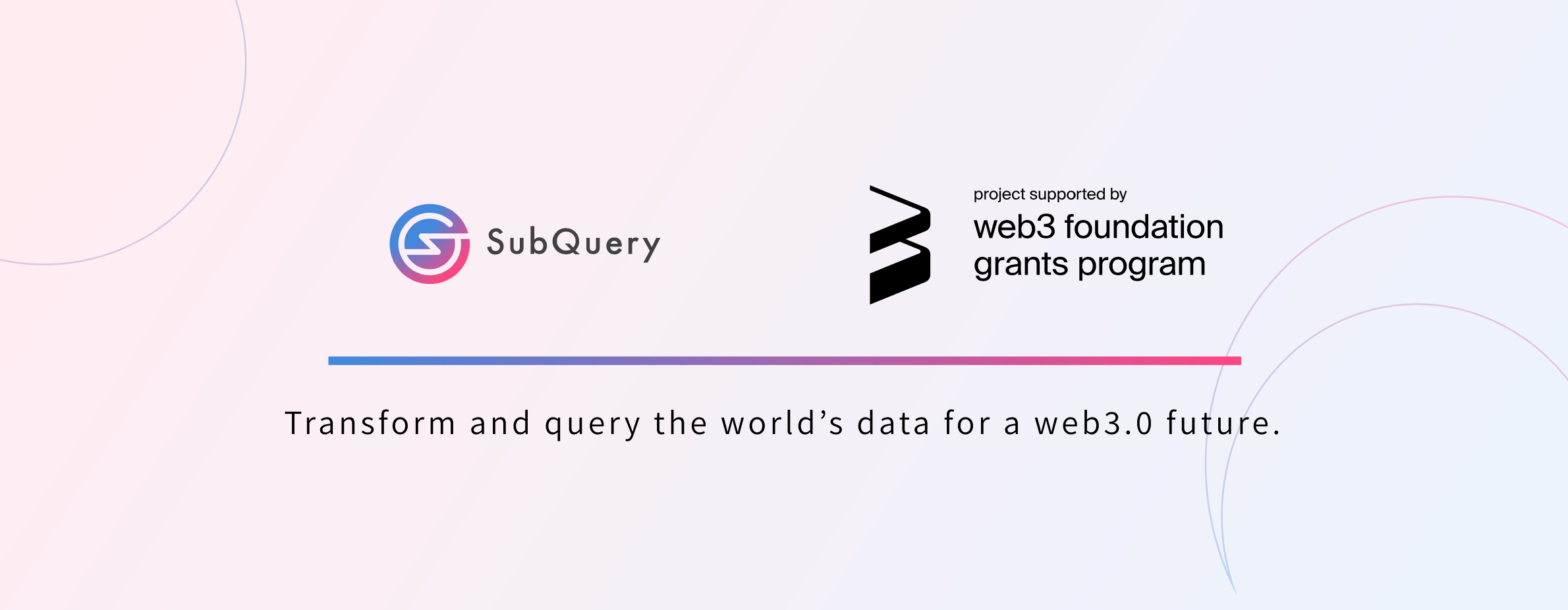what is subquery network
What is SubQuery Network | What is SubQuery Network token | What is SubQuery Network
airdrop website : https://seekers.subquery.foundation/?referral=zou1j3xa // zealy task : https://zealy.io/c/subquerynetwork/invite/IILGPX_OCIT1nIz2JueKw SubQuery’s aim is to help Polkadot/Substrate projects build better dApps by allowing anyone to reliably find and consume data faster. Our service will allow users to extract, transform, persist, and query data initially, as well as connect and present data in the future. Our aim is to make this a core piece of infrastructure for the Substrate/Polkadot ecosystem, just as The Graph has become for Ethereum.
SubQuery is here to help you transform and query the world’s data for a web3.0 future.
Announcing SubQuery
For the Web 3.0 dream to be realised, it’s got to be as fast (if not faster) than centralised networks for the end user.
That’s why we’re incredibly proud to announce SubQuery, an open source project that allows users to run an indexer across their chain to build a dataset that can be queried with GraphQL. This suite of tools includes a command line interface to allow projects to generate their own SubQuery project, defining how the indexer should traverse and aggregate their own network. There’s a SubQuery node package that indexes the network and supports GraphQL queries. With the help of these tools, anyone can create and run queries easily.
SubQuery Delivers Its Open Source SDK Following a Web3 Foundation Grant
 The Web3 Foundation Open Grants Program Deliverable
The Web3 Foundation Open Grants Program Deliverable
The Web3 Foundation Open Grants Program has enabled us to build SubQuery, an open source project that allows users to run an indexer across their chain to build a dataset that can be queried with GraphQL.
This suite of tools includes @subql/cli, to allow projects to generate their own SubQuery project, defining how the indexer should traverse and aggregate their own network. As part of our proposal, we have provided a basic tutorial that shows users how to use the cli to index their network that you can follow here. We’ve even provided more detailed developer documentation for more advanced usages.
Secondly, there’s a SubQuery node package that loads the defined SubQuery project created by the CLI and then indexes the network to a Postgres database. Using Hasura, you can run GraphQL queries right away over indexed tables. With the help of these tools, and the community support material that we’re always improving, anyone can create and run queries easily.
You can get started right away by following our example on the SubQuery Github repository: https://github.com/OnFinality-io/subql. Additionally, you can find out more by reading our SubQuery docs: https://doc.subquery.network/ or visiting our new website
We’re incredibly grateful for the support provided by Web3 Foundation to help us carry out this project for the community. Web3 Foundation funds research and development teams building the technology stack of the decentralized web. It was established in Zug, Switzerland by Ethereum co-founder and former chief technology officer Dr. Gavin Wood. Polkadot is the Foundation’s flagship project.
Why Now?
We saw Polkadot’s potential early and right from the start it felt natural to focus our efforts there. The core premise of Polkadot is to create a thriving community of developers, users, and businesses that will tap into its multichain interoperability — that community is going to need a service that allows them to reliably find and consume data quickly.
Polkadot’s unique architecture means that we can focus on one network and then be able to support multiple current and future chains with ease. Even though Polkadot is still under development, we will be there ready to help the next generation of blockchain developers create the next big dApp.
SubQuery Explorer
Since announcing SubQuery to the world just a month ago, the response and feedback we’ve received from the Polkadot community has been overwhelmingly positive. We’ve gained thousands of followers on our channels, and there have been over 1,353 installs from NPM. It’s inspiring to receive all the messages of support, and to see the engagement from the community. It’s time for us to give something back!
We’ve been working overtime over the last month to release the next major stage of our roadmap for SubQuery. Today we’re announcing the release of the SubQuery Explorer. SubQuery Explorer is an online hosted service that provides access to published SubQuery projects made by contributors around the world and managed by the SubQuery team. It furthers our mission to support Polkadot developers by providing infrastructure services by making accessing Polkadot network data even easier.
SubQuery Explorer is an online hosted service that provides access to published SubQuery projects made by contributors around the world and managed by the SubQuery team. It furthers our mission to support Polkadot developers by providing infrastructure services by making accessing Polkadot network data even easier.
Today, anyone can query and extract Polkadot network data in only minutes and at no cost.
The SubQuery explorer makes getting started easy. We’ve prebuilt SubQuery projects for two use cases (more about these below) and have indexed each network. We’re hosting these SubQuery nodes online and allow anyone to query each for free. These managed nodes will be monitored and run by the SubQuery team at a performance level that will allow production apps to use and rely on them.You’ll also note that the SubQuery Explorer provides a playground for discovering available data with example queries. You can play around with each SubQuery Graph using this explorer without implementing anything in code. Additionally, we’ve made some small improvements to our documentation to better support developers on their journey to better query and analyse the world’s Polkadot data.
Launch Use Cases
Staking Sum SubQuery Project GitHub Project Code: https://github.com/subquery/subql-examples/tree/main/sum-reward
You can quickly find total staking revenue awarded to any account since the beginning of time by querying their account address. This subquery project indexes and records the accounts participating in the staking bond on the blockchain. The continued indexing will find out obtained staking reward and slashes for this account and aggregates their sums to a database.
Validator Threshold SubQuery Project GitHub Project Code: https://github.com/subquery/subql-examples/tree/main/validator-threshold
You can quickly see the minimum staking amount required for a validator to be elected. This project is an excellent example of implementing query states in the mapping function. It first finds the active staking Era through a state query and records the validators of this session staking amount by each. It then calculates the minimum staking amount and the total amount staked in this Era. Lastly, it records the maximum number of nominators that can be rewarded.
SubQuery Integrates Acala to Aggregate and Serve DeFi Data to Polkadot and Kusama Builders
SubQuery is a data aggregation layer that will operate between the layer-1 blockchain (Acala) and DApp layer. The solution aggregates and organizes data from Acala and other blockchains, serving up well-structured data for developers to use for a wide array of projects. This service allows DApp developers to focus on their core use case and front-end, without needing to waste time on building a custom backend for data processing.
Acala is a firm believer and a long-term builder for the multi-chain future — reducing liquidity fragmentation, increasing composability, and enabling DeFi accessibility to everyone. Acala is a specialized blockchain focusing on decentralized finance (DeFi), and created multiple DeFi primitives that became a DeFi hub and infrastructure serving the Polkadot and Kusama ecosystems. The team has built products including a multi-collateralized stablecoin (aUSD — The Acala Dollar), an automated market maker (AMM) DEX, a tokenized staked asset called Liquid DOT (LDOT), and implemented a bring-your-own-gas feature allowing gas fees to be payable in any supported assets such as stablecoins. Acala’s parachain plans to play the role of DeFi hub for Polkadot and a landing pad that aggregates assets and liquidity from a variety of blockchains.
Today when you access the SubQuery Explorer you’ll be welcomed with a new Acala SubQuery Project. This SubQuery dynamically tracks all the extrinsic data created on Acala and can quickly show derived aggregated stats for the following:
- Historical Data on liquidity changes (broken down by providers)
- Historical Data on all cross chain asset swaps
- Transfer history
You can play around with the Acala SubQuery Graph using the Explorer without implementing anything in code. Additionally, we’ve documented the types that you can specify in each GraphQL request when analysing Acala’s data.
A future with a live Acala SubQuery Graph
Below is a simple example of how a user can quickly and easily see the previous 5 transfer events using the ACA token over the Acala Mandala network. You can see here that we use simple GraphQL language to sort and retrieve this data to any client. DApps can use this to monitor loan positions, and jump on auctions etc to help liquidate collaterals.A slightly more complex example follows, where we inspect a single account and retrieve all token swap events made by it. A portfolio DApp might use this data to create an overview of the holder’s account and token performance, revenue from staking, liquidity provisioning, and expenses on borrowing.
SubQuery — Transform and Query the World’s Data for a Web3 future.
SubQuery Explorer is an online hosted service that provides access to published SubQuery projects made by contributors around the world and managed by the SubQuery team. Its mission is to ease access to Polkadot network data by providing infrastructure services to help developers achieve more.
SubQuery allows every Substrate/Polkadot team to process and query their data. The project is inspired by the growth of data protocols serving the application layer and its aim is to help Polkadot/Substrate projects build better dApps by allowing anyone to reliably find and consume data faster. Today, anyone can query and extract Polkadot network data in only minutes and at no cost.
Learn More
Start querying data on the new SubQuery Explorer
Build your own SubQuery project by following our SubQuery docs
Visit our website
Talk to us on:
🔺DISCLAIMER: Trading Cryptocurrency is VERY risky. Make sure that you understand these risks if you are a beginner. The Information in the post is my OPINION and not financial advice. You are responsible for what you do with your funds orginal website full detail https://seekers.subquery.foundation/?referral=zou1j3xa https://zealy.io/c/subquerynetwork/invite/IILGPX_OCIT1nIz2JueKw




































